India’s first design university Anant National University (AnantU) has started the process of converting vacant buildings as COVID-19 recovery facilities as per their implementation plan. Earlier this week the university submitted the plan, which is being undertaken free-of-cost, to the Prime Minister’s Office (PMO). In two locations in Kerala, the process has already begun, in partnership with parliamentarians and innovators. AnantU looks forward to scaling up this process rapidly in the days ahead.
The detailed plan, which was sent to PMO and private builders to convert existing infrastructure – government-owned, community-owned, private-owned – buildings, is set to be implemented within a period of 15 days. Given the size of task and detail of preparation, Miniya Chatterji, CEO of Sustain Labs & Director of Centre for Sustainability, Anant National University, shared, “We have the teams, layouts, equipment lists, and vendors ready and can, in fact, set it up in 3 to 5 days. However, we have proposed 15 days given the predictability of delivery time for ICU and other equipment.” The AnantU’s Centre for Sustainability has been doing extensive research on the locations and reasons for vacant houses in India – the information to be useful in the process.
The urgency for recovery facilities is substantial given the fact that there has been a sharp growth in the confirmed cases of deaths in India and the recoveries have slowed down. Several experts had long pointed out that India has a large number of buildings that are just vacant and can be used for isolation wards. A report suggests of Census 2011 recorded 330,835,767 houses, 7.5 per cent (24,812,682) of the houses are vacant and 95 per cent of these vacant houses are in good and liveable condition. The Indian Railways has started converted its empty carriages into isolation wards. Several builders separately on their own have given unoccupied residential units to municipal authorities for quarantine facilities. However, to see a significant contribution from the private players in the given plan, there need to be financial incentives in place.
